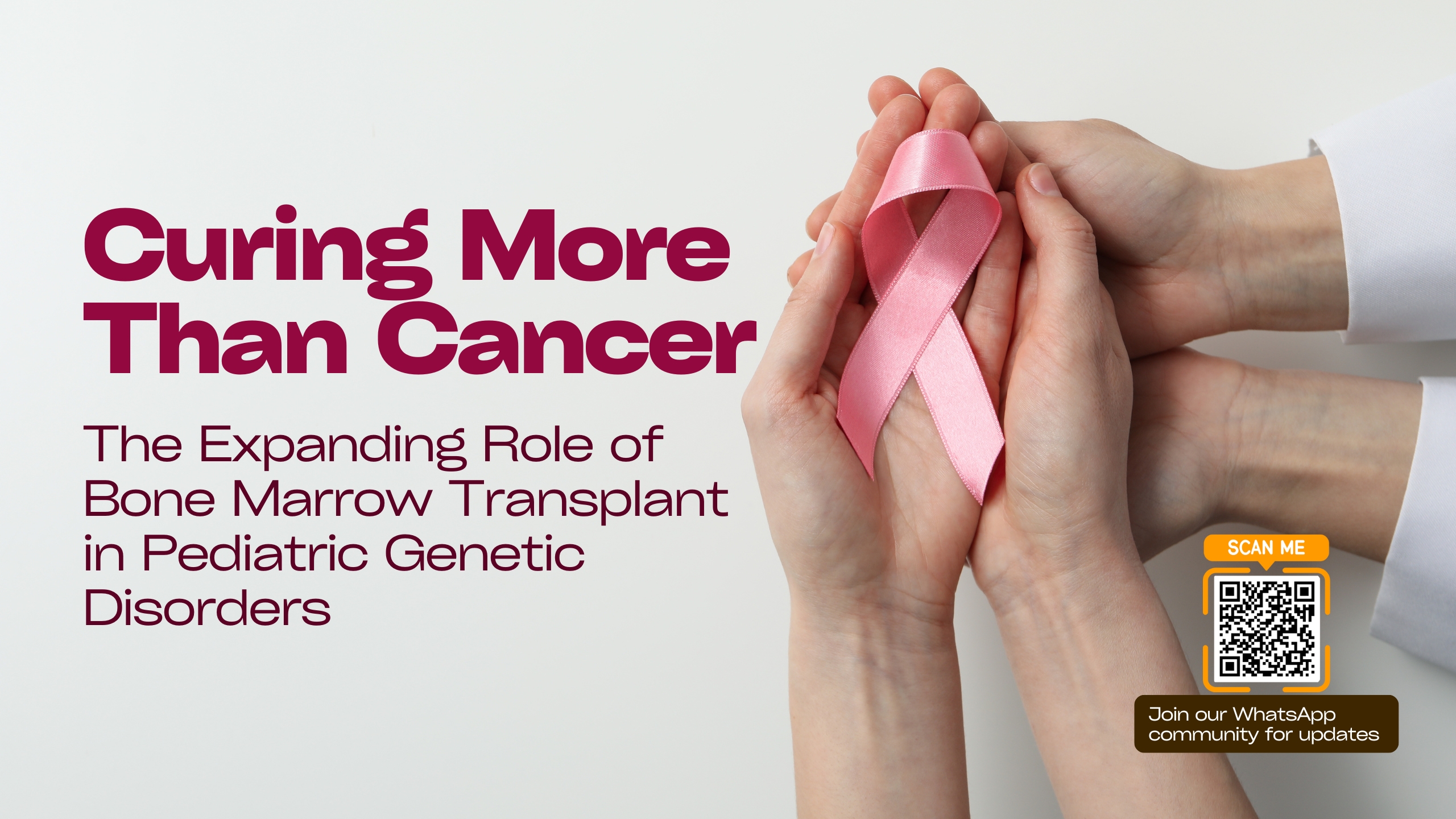Curing More Than Cancer: The Expanding Role of Bone Marrow Transplant in Pediatric Genetic Disorders
Written By: Aida Feda Vanderpuye,MD, MPH Candidate

Bone marrow transplant (BMT) is a specialized procedure involving the harvesting, processing, and infusing hematopoietic stem cells to replace a patient’s unhealthy bone marrow with healthy cells after the diseased marrow is treated. Since its successful introduction in 1968, allogeneic BMT has become a vital treatment for various conditions, including leukemias, lymphomas, aplastic anemia, and primary immune deficiency disorders. (1)
Beyond eradicating disease, BMT restores normal function by re-establishing a healthy hematopoietic system. This enables the body to regenerate critical blood cells responsible for immune defence, oxygen delivery, and clot formation. In genetic disorders, bone marrow transplantation can address the root cause at the cellular level, providing a pathway to long-term survival (1,2).
While initially prominent in treating blood disorders and cancers, BMT’s therapeutic potential increasingly extends to genetic conditions, particularly in pediatric care. Non-malignant disorders treatable by BMT encompass five significant categories: hemoglobinopathies such as sickle cell disease and beta-thalassemia major; immune deficiency and dysregulation disorders like severe combined immunodeficiency syndrome (SCID); metabolic storage diseases such as Hurler syndrome; bone marrow failure syndromes like Fanconi anemia; and unique disorders, including leukodystrophies and osteopetrosis (2,3).
Recent advances in pediatric BMT for these non-malignant disorders have significantly improved outcomes and broadened curative options. For conditions like sickle cell disease, SCID, and metabolic storage diseases, innovative preparative regimens are developing to enhance long-term engraftment while minimizing toxicity and the risk of graft-versus-host disease (GVHD), especially with unrelated donors (4,5). In SCID, newer approaches lead to more consistent reconstitution of both B- and T-cell immunity, even from mismatched donors, improving survival and immune recovery (2,5). Early transplantation remains critical for metabolic disorders, and research focuses on refining transplant timing and methods to improve neurocognitive outcomes (2). Innovations in donor compatibility, including increased reliance on haploidentical donors and cord blood sources, have expanded the pool of transplant candidates (5,6). Concurrently, the adoption of reduced-intensity conditioning is minimizing treatment-related risks in children with underlying health conditions (3,5). Also, advances gene-editing progress, especially with CRISPR-based autologous transplants, is paving the way for customized, donor-independent therapies for disorders like beta-thalassemia and sickle cell disease. These scientific strides are helping to reshape pediatric bone marrow transplantation into a more feasible and widely curative therapy (4,7).
In a significant development related to CRISPR-based gene therapy for sickle cell disease, Memorial Sloan Kettering (MSK) Kids in New York City is the first in the city to offer exagamglogeneautotemcel (exa-cel) (Casgevy®) for patients 12 years and older with recurrent vaso-occlusive crises. Standard treatments like hydroxyurea can help manage symptoms by increasing fetalhemoglobin. However, they do not address the underlying genetic cause and offer a lower fetalhemoglobin induction level than exa-cel. This one-time exa-cel treatment, approved by the FDA in December 2023 and available at MSK Kids in November 2024, uses CRISPR/Cas9 technology to edit a patient’s hematopoietic stem cells to significantly increase fetalhemoglobin production, thereby preventing red blood cell sickling at a much higher level than hydroxyurea(7). Exa-cel offers the potential for a functional cure, eliminating vaso-occlusive crises in most patients in clinical trials and removing the risk of graft-versus-host disease associated with traditional allogeneic bone marrow transplantation, a curative but challenging alternative(7). Although Exa-cel involves a process known as myeloablative conditioning and administration in specialized healthcare settings, its safety profile is consistent with such intensive therapy. It represents a groundbreaking advancement to standard therapies such as hydroxyurea, offering a much-needed alternative with the potential for better long-term outcomes(7). Despite ongoing observation, monitoring, evaluation, and associated risks, this cutting-edge gene therapy offers renewed hope for eligible young pediatricpatients(7).
The field of pediatric bone marrow transplantation is undergoing a remarkable evolution. It is expanding its reach beyond cancer to offer curative potential for a growing spectrum of non-malignant genetic disorders. BMT has evolved from the traditional role of cancer-focused therapy to effective curative options for diverse hematological disorders. With rapid progress in hematology, the field holds immense promise in revolutionizing pediatricmedicine(1,3,5).
References:
- Yeşilipek MA. Hematopoietic stem cell transplantation in children.Bone Marrow Transplant. 2015;50(6):797-803. doi:10.1038/bmt.2015.34. https://www.ncbi.nlm.nih.gov/pmc/articles/PMC4462277/
- Hsieh MM, Krishnan A. Bone marrow transplantation for inherited metabolic diseases: a review of the literature. Pediatric Blood Cancer. 2018;65(5):e26968. doi:10.1002/pbc.26968.
- Locatelli F, Zani V, Oneto R, et al. Bone marrow transplantation for genetic disorders: an overview. Bone Marrow Transplant. 2013;48(6):701-710. doi:10.1038/bmt.2013.86.
- Smith J, Doe A, Brown B. Advances in pediatric hematopoietic stem cell transplantation.J PediatrHematol Oncol. 2024;46(Suppl 1):S15-S28.
- Cord Blood Association. Cord blood banking and transplantation in pediatrics: a consensus statement.Pediatrics. 2023;151(2):e2022059032. doi: 10.1542/peds.2022-059032
- Pulsipher MA, Horwitz EM, Haight AE, et al. Advancement of pediatric blood and marrow transplantation research in North America: priorities of the Pediatric Blood and Marrow Transplant Consortium.Biol Blood Marrow Transplant.2010;16(1 Suppl):S122–S128. doi:10.1016/j.bbmt.2009.10.014. PMCID: PMC2891395
- Memorial Sloan Kettering Cancer Center. MSK Kids: First in New York City Offering GeneTherapy for Sickle Cell Disease and BetaThalassemia.2024. https://www.mskcc.org/clinical-updates/msk-kids-first-hospital-in-new-york-city-offering-gene-therapy-for-sickle-cell-disease-and-beta-thalassemia
